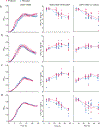Community composition and the environment modulate the population dynamics of type VI secretion in human gut bacteria
- PMID: 37884689
- PMCID: PMC11099977
- DOI: 10.1038/s41559-023-02230-6
Community composition and the environment modulate the population dynamics of type VI secretion in human gut bacteria
Abstract
Understanding the relationship between the composition of the human gut microbiota and the ecological forces shaping it is of great importance; however, knowledge of the biogeographical and ecological relationships between physically interacting taxa is limited. Interbacterial antagonism may play an important role in gut community dynamics, yet the conditions under which antagonistic behaviour is favoured or disfavoured by selection in the gut are not well understood. Here, using genomics, we show that a species-specific type VI secretion system (T6SS) repeatedly acquires inactivating mutations in Bacteroides fragilis in the human gut. This result implies a fitness cost to the T6SS, but we could not identify laboratory conditions under which such a cost manifests. Strikingly, experiments in mice illustrate that the T6SS can be favoured or disfavoured in the gut depending on the strains and species in the surrounding community and their susceptibility to T6SS antagonism. We use ecological modelling to explore the conditions that could underlie these results and find that community spatial structure modulates interaction patterns among bacteria, thereby modulating the costs and benefits of T6SS activity. Our findings point towards new integrative models for interrogating the evolutionary dynamics of type VI secretion and other modes of antagonistic interaction in microbiomes.
© 2023. The Author(s), under exclusive licence to Springer Nature Limited.
Conflict of interest statement
Competing Interests Statement
No competing interests are declared by the authors.
Figures








Update of
-
Community composition and the environment modulate the population dynamics of type VI secretion in human gut bacteria.bioRxiv [Preprint]. 2023 Feb 21:2023.02.20.529031. doi: 10.1101/2023.02.20.529031. bioRxiv. 2023. Update in: Nat Ecol Evol. 2023 Dec;7(12):2092-2107. doi: 10.1038/s41559-023-02230-6. PMID: 36865186 Free PMC article. Updated. Preprint.
References
-
- Young VB The role of the microbiome in human health and disease: an introduction for clinicians. BMJ 356, j831 (2017). - PubMed
-
- Zmora N, Suez J. & Elinav E. You are what you eat: diet, health and the gut microbiota. Nat Rev Gastroenterol Hepatol 16, 35–56 (2019). - PubMed
-
- Falony G. et al. Population-level analysis of gut microbiome variation. Science 352, 560–4 (2016). - PubMed
Publication types
MeSH terms
Substances
Grants and funding
LinkOut - more resources
Full Text Sources
Molecular Biology Databases

